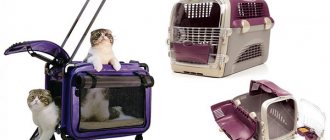Some friends suggested that I give the cat into good hands so as not to bother with him, but I categorically refused such recommendations, since I consider it a betrayal of the animal to give it to strangers (even not strangers). Honestly, I don’t understand people who can so easily get rid of their pet because of some inconvenience.
In this article I will share my practical recommendations for transporting cats on a Russian Railways train and my impressions of the first trip with a cat on the train.
Veterinary certificate
Back in 2022, every cat owner who wanted to place their animal on a train had to visit a veterinary station and purchase a health certificate for their pet. The validity period of the certificate was limited, so those people who came for it in advance risked being left on the day of the trip with a useless, invalid piece of paper. This document was valid for only five days, which meant that literally a couple of days before the trip the owner had to visit the veterinary station.
Many owners consider visiting the veterinary station the most tedious preparation point
When traveling abroad, two veterinary certificates are required - in Russian and in the language of the country you are traveling to. English is often used as an international language.
Sample of an international veterinary certificate
There were no provisions for any tests on the territory of the veterinary station itself. The cat owner must come with an existing veterinary passport, which contains information about all vaccinations performed and the health status of the animal. Vaccination had to be done no more than a year, and no less than a month before departure.
Required vaccinations
The situation is further complicated by the fact that there is no single list of required vaccines. In this matter, each veterinary station shows itself “creatively”. For some specialists, a rabies vaccination is enough, while others require vaccination against:
- Rhinotracheitis;
- Calcivirosis;
- Panleukopenia.
As a rule, veterinary stations do not inspect animals and issue certificates based on existing documents
It is difficult to predict the vagaries of each specific station, so universal vaccination was the optimal solution. Even before vaccinations, the cat had to be dewormed in order to avoid side effects from vaccination. In short, the pet owner faced a difficult and exhausting journey from the veterinary station to the treasured railway station.
Required documents
Not so long ago, all cats were required to obtain a special certificate from a veterinarian to travel on trains, and many still think that this is necessary. But since 2022, this requirement has been abolished; a pet will need a veterinary document only if its transportation is directly related to business (for example, if a cat is being transported for sale). In this case, you cannot do without a veterinary passport, which will contain notes about the vaccinations given.
Condition of the cat after transportation
After the move, the animal, of course, continues to experience stress. This happens not only because of the transportation itself, but also because the animal ends up in a completely new place for it, in a new apartment.
Basically, the behavior of the animal is as follows:
- refusal to eat for several days (1-3 days);
- refusal to go to the toilet (up to 24 hours after moving);
- the animal does not make contact with the owner, hides under the sofa or in another secluded place.
After 2-3 days, this condition passes and the cat begins to behave as usual. After a week, Mars had already completely settled down - his appetite returned, he began to go to the litter box and behave like the master of the house.
Reform 2022
If after all these frightening descriptions you go to unload your suitcases, then don’t rush. In January 2022, another amendment was adopted, this time transforming all preparations for the trip beyond recognition. Pet health certificates were abolished. Abolition, however, does not mean a complete lack of control over the pet’s condition on the part of Russian Railways employees.
Don't be confused if you meet an ignorant guide and explain the situation clearly to him
As already mentioned, all orders from above spread to the ground at a snail's pace. Therefore, if you arrive fully armed, with knowledge of the changed legislation, there is no guarantee that you will not meet an employee who will certainly ask you for an animal passport. Moreover, if you call the company and start asking different specialists questions on this topic, you may well hear mutually exclusive information.
Often Russian Railways employees themselves have conflicting information and cannot agree on the issue of transportation
The main points that you should take away from the winter reform are as follows:
- Transportation rules now depend on which compartment you choose. Some types of compartments, which we will talk about next, are not accessible to animals;
- The size of a cat is no longer determined by its physical characteristics, but by the carriage in which the animal is placed;
- You cannot purchase a single “cat” ticket - for each train and each type of car the price is set individually.
- Sleeping and luxury carriages remain inaccessible to cats.
Often Russian Railways employees themselves have conflicting information and cannot agree on the issue of transportation
Despite the fact that having a veterinary passport and related certificates is no longer mandatory, it does not mean that the owner can safely ignore this document. We will talk further about why a veterinary passport is needed and what its useful functions are.
Veterinary passport for a cat
Video - current transportation rules
Sending an animal unaccompanied – is it possible?
The Russian Railways company provides a service for transporting cats unaccompanied by a person in the luggage compartment. When purchasing a travel document, the owner writes an application for the provision of this service
It is important to comply with the following requirements:
- The pet must be in a cage or carrier the entire journey.
- The carrier comes with accompanying papers, drinking water, food, bowls, one toy and disposable diapers.
The cost of such travel depends entirely on the duration of the route. The entire period of the mustache does not remain without careful supervision. The four-legged animal will be looked after and looked after by railway workers.
Despite this, it is better to use this option only in extreme cases - a trip among unfamiliar people and smells will cause severe stress even in the calmest pet.
Possible problems and advice from experienced travelers
When planning your trip, you should think about the trip in advance, especially if it will take place with your beloved pet. Forethought will help people and cats endure the road comfortably. The main requirement of any trip is to ensure the safety of all participants - the animal itself, the owner, and other passengers.
Microchip implantation
To move a cat across the country, microchipping is not a requirement. This procedure must be done before rabies vaccination. This is regulated by current EU regulations. The chip itself looks like a small grain, the size of a grain of rice. It is implanted under the skin on the animal’s withers so as not to create discomfort.
A barcode is entered into the veterinary passport, which is also entered into the electronic database. It first appeared in the European Union, then moved to the USA and Canada. In these countries this procedure is mandatory. Owners who fail to do this face a heavy fine.
The main idea of chipping is to make it easier to find “lost items” so that if found, they can be returned to the owner. Also, all information about a given belly is recorded on the chip, including its vaccinations, diseases and other data.
If during the trip the cat opens its mouth and breathes rapidly during transportation, this indicates that it is motion sick. In this case, you can give medications for motion sickness, if possible, provide a flow of clean air, and give water. It is not advisable to feed a cat in this condition.
What does a cat need on the road?
In order for your pet to survive a long trip, you need to have some items with you. Be sure to stock up on the following:
- carrying;
- tray;
- harness;
- water;
- dry food;
- napkins;
- disposable waterproof diapers;
- soft bedding;
- Trash bags;
- sedatives;
- disinfectant against unpleasant odors.
All of these items will be useful, especially during a long trip.
Is a container required for transportation?
A bag for transporting cats is a must, regardless of the chosen transport. It is not recommended to take out an animal while traveling, since in a state of fear it can simply run away, bite, scratch and escape from your hands.
The container must be made of plastic, have a solid bottom, and a mesh. These are the basic requirements that most airlines require for this cat accessory. Although a soft backpack for transporting cats is more convenient for the owner of the animal, it is unlikely to be suitable for a flight.
The nuances of transporting kittens
Many carriers do not accept kittens under four months of age for transportation. This is due to the fact that such kittens, due to their age, cannot receive some mandatory vaccinations. Many of them are placed only at three months, but must undergo quarantine. It is better to transport kittens with their mother. One or more kittens are not allowed.
Sedatives for cats
Using sedatives will reduce your cat's stress. It is advisable to coordinate the choice of a specific drug with your veterinarian. If you plan to travel by plane, sedatives for cats during transportation can be dangerous.
An overdose of the drug can also only cause problems, and sometimes even cause death.
How to prepare a cat for flight
For several days, the cat’s food should be limited, but not completely. Access to water must remain unrestricted. It is worth preparing a carrier, toys and other necessary items in advance.
Preparing for the trip
Before setting off on a long journey with your pet, it is advisable to do a number of simple manipulations that will make the trip easier for both the cat and you in the future:
- Implant a chip into an animal. Despite the fact that this advice sounds somewhat threatening, many owners resort to this procedure. When transporting a cat, the likelihood of its loss increases, and no one can be 100 percent insured. The chip will allow you to determine the location of the cat using a special program in case of its escape and will save you from tedious searches;
The miniature chip does not harm the animal’s body and is not felt by it in any way.
- Give your pet worm prevention three months before the departure date. The absence of the need to have a veterinary certificate should not entail a special lack of responsibility for your pet. This way you will protect yourself and your possible travel companions from possible infection;
Dirofen in the form of a suspension is literally created for pets who cannot tolerate tablets
- Make sure you have all your cat's required vaccinations throughout the year.
Carrying bag
I will dwell in more detail on the carrying bag. You can purchase either a hard carrier (plastic or metal) or a soft one. I have a soft fabric one with a rigid frame.
I recommend placing a pet diaper (available in pet stores) at the bottom in case the animal goes to the toilet directly in the bag (which is most often excluded). Also, bedding will not hurt if the cat has a plastic carrier. The animal will be more comfortable on a soft diaper or blanket.
Absorbent animal bedding
Mars traveled in such a soft carrier
Transporting cats on high-speed trains
There is no single set of rules for transporting cats that is valid for every train. Before setting off, the owner should familiarize himself with all the possible options and weigh the pros and cons.
Table 1. Rules for transporting cats on high-speed trains
| Train | Requirements | Price |
Peregrine Falcon | In Sapsan, cats are transported in specially designated places in the third and eighth carriages for economy class passengers. In first and business classes, space for passengers with pets is available in the third carriage. The weight of the container together with the animal should not exceed 10 kg, the container itself should be no more than 120 cm | 900 rubles in first and business class. In other carriages the cost of transportation is included in the ticket |
Swift | On this train, cats can be transported in class 2B carriages. There is strictly one carriage per travel document. Containers must contain no more than two pets. The size of animals when summing up three dimensions (width – height – length) should not exceed 180 cm | The cost of transporting each individual individual is negotiated individually |
Martin | In Lastochka, transportation of cats is permitted in class 2C and 3C carriages. Passengers with animals are allocated special seats in the fifth and tenth carriages. There are also luxury places where you can also accommodate cats, but for an additional fee. A passenger can take one container, which will contain no more than two individuals. The dimensions of pets in the sum of three dimensions should not exceed 180 cm | 150 rubles |
Swallow premium | The difference between the conditions of a premium swallow and an ordinary swallow is the greater number of places for cat lovers, concentrated in the fifth car. For an additional fee, it is possible to reserve seats of increased comfort. A passenger can take one container containing no more than two individuals. The dimensions of pets in the sum of three dimensions should not exceed 180 cm | 150 rubles |
Allegro | Seats for passengers with cats in Allegro are located in the sixth carriage. There are no special seats available for an additional fee. Transported pets must be in containers whose dimensions do not exceed 60x45x60 cm | 15 euros |
Requirements
Russian legislation regulates the transportation of animals:
- “General rules for the transportation of goods by road”, approved by the Ministry of Transport of the RSFSR on July 30, 1971, as amended. 05/21/2007 and Resolution of the Russian Federation No. 272 of 04/15/2011. You can read more about the content in Section 25 “Rules for the transportation of animals and birds”.
- “Veterinary and sanitary rules for the transportation of animals, poultry, fish, products and raw materials of animal origin by road transport” (approved by the State Agricultural Industry of the USSR on January 30, 1986 N 432-5).
According to them, when transporting four-legged animals in a car, documents are not needed in the following cases:
- in the city;
- In the countryside.
Documents are needed if the owner goes:
- outside the region;
- to hunting grounds;
- for fishing in a protected area.
According to the requirements of the law, territory guards and the police can demand documents for them. To do this, you need to provide a dog passport with all vaccinations or a hunting license. The rules for transportation in a car are also prescribed by law.
The main requirement is that the pet:
- did not interfere with the driver's control of the vehicle. The safety of everyone, including pedestrians, depends on this. For this reason, they should only be placed in the rear passenger seats or in the trunk;
- was securely fastened or was in a tightly closed, secure, portable device with quality fastenings. The means used must ensure the safety of all road users;
- did not pollute the interior, ensured the maximum possible cleanliness in the cage in this case, especially when using a hired mode of transport (taxi services).
Legislative regulation
Every owner must follow the current rules for transporting cats by train. To do this, you need to delve into the essence of the issue and its subtleties.
The portal’s lawyer will help you deal with them; you can send a request to him on the site at any time.
After filling out the pop-up form, the consultant will give advice on the rules for transporting cats on trains.
Regulations for the transportation of animals by rail are mandatory for all passengers. Any citizen, having purchased a ticket, automatically agrees to comply. Violation of these will result in prescribed penalties.
The legislative framework in this area consists of:
- Charter of railway transport No. 18-FZ dated 10/01/2003 as amended in 2022.
- The Order of the Ministry of Transport of the Russian Federation approved the Rules for the transportation of passengers and luggage No. 473 dated 12/19/2013 in the new edition of 2022 certified by the Ministry of Railways of the Russian Federation and standards for the delivery of animals by rail.
Watch the video: “How to transport a cat on a train.”
Travel registration
Nowadays, tickets are purchased in two ways, which determine the specifics of further actions:
- Order a ticket via the Internet. As a rule, on the websites of railway companies, when purchasing a ticket, you can select all the additional functions, which include transporting a pet, which will increase the cost of the ticket. Upon arrival at the station, you just need to show your passport and present the ticket printed from the website;
When ordering a ticket through the website, pay attention to the carriages marked with the letter Z - these are the ones you need
- Purchasing a ticket through the station ticket office. When purchasing a ticket directly, you inform the cashier about the presence of the animal and discuss the package of necessary documents and the final cost of the ticket, after which you redeem it.
It is advisable to notify Russian Railways employees of your intention to transport the animal in advance (two to three days before the day of departure). You can do this by calling the toll-free number 8-800-222-07-66.
The simplest procedure for transporting a cat applies to all trains
Please note that commuter trains do not require containers. It is enough to pay an additional fee for the animal, and entry into the carriage is open.
conclusions
So, let's summarize. Your main actions if you plan to transport a cat by train to the Russian Federation:
- Find your way around the flight.
- Call the Russian Railways help desk (or the carrier) and find out whether pets can be carried on this flight and in which carriage. Find out more about the conditions.
- Issue a receipt for transporting your pet. You can do this in parallel with purchasing a ticket for yourself or after, presenting your ticket when issuing a receipt.
- Buy a durable cat carrier.
How to transport on an airplane?
Is it possible to transport a cat on an airplane? Yes, if you collect all the necessary documents and prepare for the trip, following the airline's rules and customs requirements.
Airlines usually offer two options for transporting a cat - you can either take it into the cabin or transport it in the luggage compartment. Check in advance what maximum weight animals can be taken on board the plane. Typically this weight is 8 kg. If your cat weighs more, she will have to travel in the luggage compartment.
When purchasing a plane ticket, indicate in advance that you will be traveling with an animal. The fact is that a limited number of animals can travel in the cabin of an airplane on one flight, so you need to communicate your desire to transport a cat in advance. Also check whether you need to pay extra for transporting animals.
Before transporting a cat on a plane in Russia, you need to obtain a certificate from a veterinary clinic, as is the case with train travel.
When buying a plane ticket, immediately order a reservation that allows you to transport animals. Each air carrier has its own rules, we recommend that you familiarize yourself with them in advance.
The fact is that some companies allow pets to be transported in the cabin, others require reservations, and still others prohibit it altogether (the cat is placed in the luggage compartment).
Each airport has a veterinary control post. There you need to put the strain on form No. 1. Upon arrival at your destination, another stamp is placed. If there are transplants, everyone needs to undergo this procedure.
Next, the cat and the container are weighed and the overload is paid. Paying extra money is, of course, unpleasant, but nothing can be done, these are the rules today.
To transport a cat on a plane abroad, you need to do the same as in Russia, but you must have an international veterinary passport.
Buying a ticket and reserving a place for a cat
Take your time to buy tickets for a suitable flight; first you need to make sure that your cat will be taken on it.
To do this, you must first book your tickets. The ticket class must support free changes, as you will have to bring your cat in as oversized luggage. If changes cannot be made to tickets or they are paid, then it will cost you a pretty penny. Using S7 as an example: it is not profitable to buy tickets in the Economy Basic tariff, since they require an additional fee for making changes, it is better to take Economy Flexible. Don’t be too lazy to look at the full rules of the fare for which you are buying a ticket in advance, so that there are no unpleasant surprises later.
Once you've booked your ticket, call the airline to request your cat. S7 asks you to call at least 48 hours before departure to check whether an animal can be transported on this flight; Aeroflot in just 36 hours. The operator will ask you the weight of the animal with the carrier and its dimensions in cm. He will also ask whether you want to carry the animal in the cabin or agree to put it in your luggage. After clarifying the details, you will be asked to call back in a few hours. During this time, the transportation will be coordinated, and when you call again, you will be told whether you can take the animal with you, and where it will be assigned, in luggage or in the cabin.
We sit in Domodedovo for 7 hours. People around are interested in us, cats are unhappy and silent, they refuse to drink and eat
After approval, you can pay for tickets. We encountered an unexpected problem: our reservation with S7 did not want to be paid by card online. A call was made to the operator, who suggested that after making changes to the reservation, it can only be paid in Svyaznoy, Euroset and similar places, but not online. We urgently went to Svyaznoy and paid for tickets there without any commission.
Veterinary certificate form No. 1 for flight*
If your flight is related to the sale of an animal, or you are going to an exhibition, you must contact the city veterinary service 3 days before departure. There, based on an examination, a current rabies vaccination in the veterinary passport, and a note on deworming, a Veterinary Certificate in Form No. 1 will be issued. Some clinics require more vaccinations, heartworm testing, and flea and tick treatment. Call your state veterinarian in advance to find out what they specifically ask for in order to issue an F-1 certificate.
Not all state veterinarians are aware of the law that came out in 2022, and that airports have stopped requiring additional paperwork for cats. Ours was not in the know and tried to convince us of the need for a pre-flight inspection, but we did not listen to him, because we had previously called the veterinary control of Koltsovo and clarified everything with them in detail. I also advise you to call the veterinary control at the airport of departure. It is he who will allow you onto the flight, so it is better to find out in advance whether they are aware of the new requirements and whether they will allow you on the flight with just your passport.
Iriska gave up at the end of the transplant, was breathing heavily and trembling. When we arrived at the scene, everything turned out to be okay with her.
Should you feed and water your cat before the plane and during the flight?
It is better not to feed your cat immediately before the flight. It is easier to transport it on a plane on a half-empty stomach. It worked out like this: at 11 pm the cats were fed, at 2 am we left the house, arrived at the airport at 3:30 am and flew out at 5:10 am. Neither of the two vomited or had diarrhea, although by the end of the transport the diapers underneath were yellow with urine.
Our journey ended at 17:30 the next day. All this time, both cats did not eat, did not poop, but peed. During the 7-hour transfer, I force-fed both of them, pouring several caps of water into them. If your flight is much shorter, then you don’t have to drink. We also took them wet food in bags; they allowed it in their hand luggage without question. It was not possible to feed; the animals did not look at the food at all.
Should you give your cat a sedative on a plane?
You should not give your cat sedatives before a plane. Due to the rapid change in atmospheric pressure during ascent and descent, the cardiovascular system may not be able to cope with the overload, even leading to death. If the cat is nervous and noisy, then transportation on an airplane is contraindicated for it; you need to look for other ways.
Our cats flew in the luggage compartment, so we don’t know how they behaved (quietly or loudly), but while they were with us in Koltsovo and Domodedovo, they were silent, huddled in the corner of the carriers.
We transport it in a car
If you have to transport your cat or kitten long distance by car or just go to the vet, you will need to prepare for this in advance. How to transport a cat and what will you need for this? Even for the shortest trip, you will need a special carrier - after all, always carrying your pet in your arms is impractical and unreliable. There are different types of carriers, and each has its own features and advantages.
There are no requirements as such for transporting a pet in a car, but there are recommendations that are highly advisable to follow.
Before transporting your cat in a car, make sure you have it under control. You can put her in a container or soft carrier, or just keep her on a leash. The main thing is that it cannot move around the inside of the car. This is fraught with the fact that the fluffy will have the opportunity to jump out of the window (on a busy highway this can cause an accident) or interfere with the driver, creating an emergency situation.
Transportation of an animal by a transport company or with a private owner
On the Internet you can find a company that transports animals without an owner. There are two options: by car or by train. By car. The carrier can be either an individual or a company. The animal must sit in the carrier the entire way. The downside is that it is impossible to check how the animal is being transported. The driver may lock the cat or dog in the trunk or forget to feed it. In addition, transportation is expensive, for example, delivering a cat from Moscow to St. Petersburg costs at least 6,400 rubles. The price increases in proportion to the length of the route. Transporting a cat from Moscow to St. Petersburg is more expensive than by plane or by train. You buy a train ticket and pay for escort services. That is, for a large dog you will have to buy out the entire compartment, buy the carrier a return ticket and pay several thousand rubles for his services. You can save a little if you find a person from the desired city who will not need a return ticket.
Is it necessary to buy the entire compartment if you are traveling with a pet?
This restriction is established only for SV carriages and luxury cabins. To travel with a cat in a classic coupe, you do not need to buy all the shelves. All you need is a ticket for yourself and a receipt for the transportation of your tailed friend. It does not hurt to clarify detailed information on this issue with the carrier.
- "Allegro" - transportation on a paid basis in the places provided for this.
- "Sapsan" - carriage on a paid basis in economy, business and first class carriages in designated seats. At the same time, only one animal or bird can be issued for one ticket. Placing more than two pets in one place is also prohibited. In a negotiation compartment, you are allowed to carry no more than one pet per seat and no more than four animals per compartment.
- "Strizh" - transportation is paid in a "2B" type carriage.
- "Swallow" - travel is paid in special places. No more than one pet per ticket and no more than two per seat.
Not all carriages of JSC FPC allow pets, so before purchasing a ticket, you should make sure that such a service is provided in the carriage. If the train belongs to another carrier, you should clarify in advance exactly how the process is carried out.
If, in the opinion of Russian Railways employees, a large animal poses a potential threat and may be dangerous for passengers, their owners may be denied transportation.
As for larger dogs, they should be transported in a vestibule, kept on a leash and muzzled. However, the presence of more than two large dogs in one carriage is not allowed. You will also need to pay additional transportation fees.
Video about transporting animals
The travel of pets on trains with their owners is subject to strict rules. It is not possible to carry out transportation in all types of wagons. Before buying a ticket, you should check with the cashier whether transporting animals is allowed and how much it will cost.
Electric trains
Transporting animals on commuter trains has been simplified as much as possible. Dogs, regardless of size, must be muzzled and on a leash. Large breeds are allowed to be transported only in the vestibule, and only two “heavyweight” animals can be in one carriage.
Cats with a calm nature do not need to be carried. Cages with birds and small rodents also do not require additional space - they are held in hands. But it is necessary to buy a ticket for any animal other than a guide dog. This can be done at suburban ticket offices or directly at the controllers if the passenger boards at an intermediate station. The cost of travel for animals is 25% of the standard ticket price. Such a document cannot be purchased from vending machines; it must be stamped accordingly.
As a rule, ticket inspectors are rarely interested in tickets for four-legged passengers, especially if they sleep peacefully on the owner’s lap, differing little from ordinary luggage. But when it is discovered that a cat or dog is riding as a hare, you will have to pay a fine.











